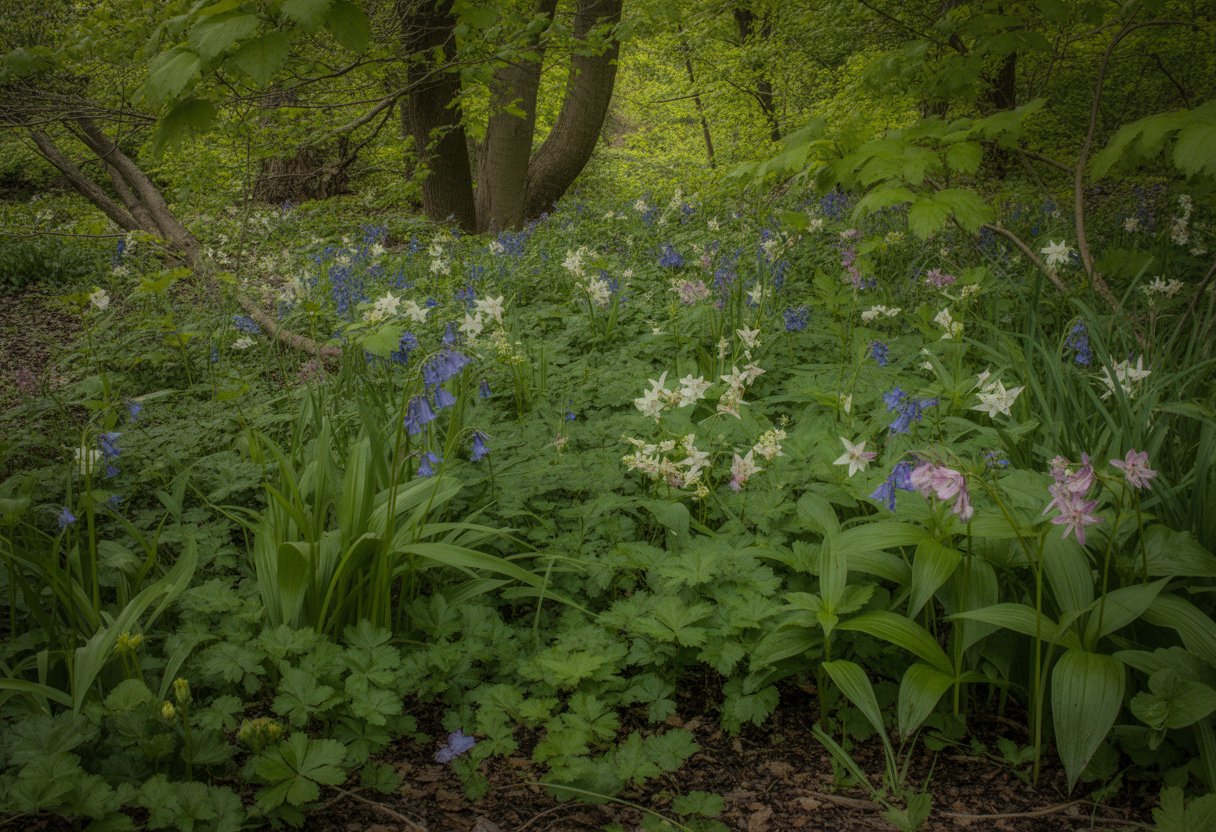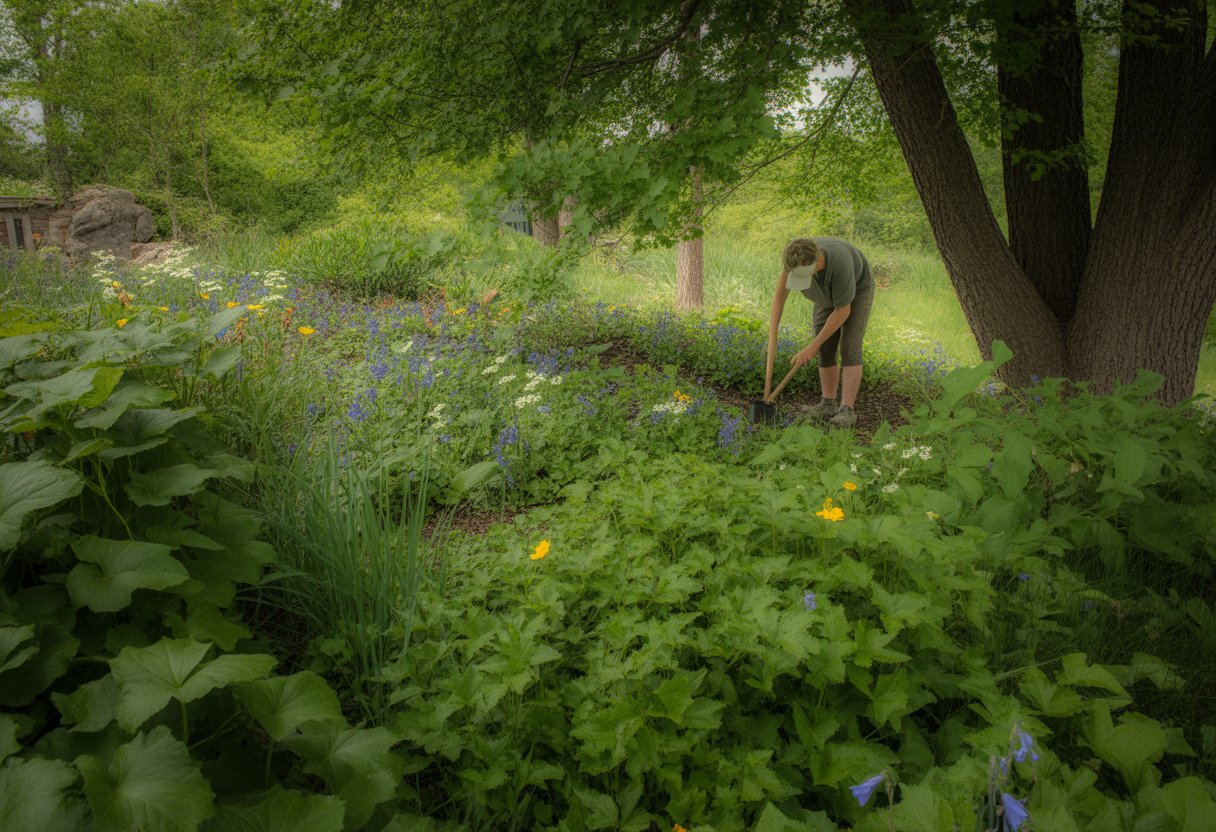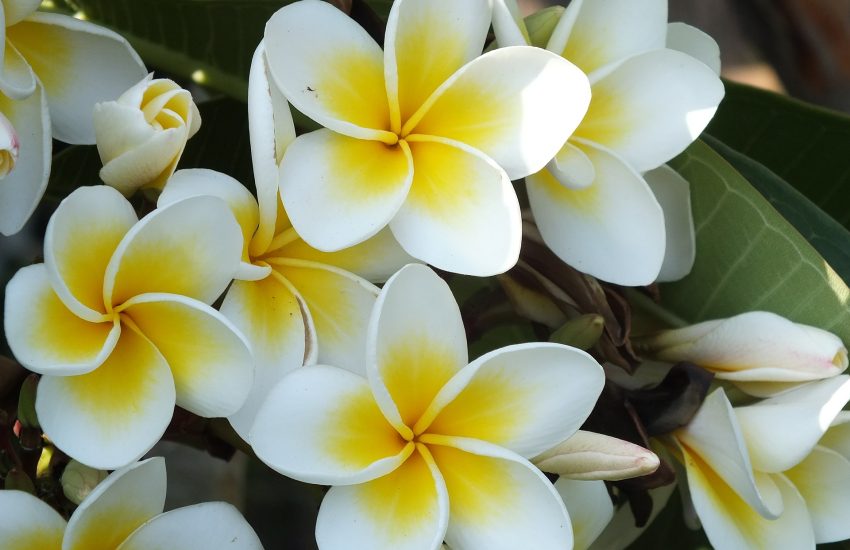Wildflowers for Shady Gardens Ohio: Best Varieties and Planting Tips
Gardening in Ohio’s shady spots can feel tricky, but wildflowers are a surprisingly tough fix. Plenty of species don’t mind low light and actually seem to thrive in Ohio’s climate.

For shady gardens in Ohio, species like Virginia Bluebells, Foamflower, and Christmas Fern provide color and texture without needing full sun. These plants brighten up dark corners and help out local pollinators and wildlife, too.
Picking the right wildflowers for shade lets you build a lively, sustainable landscape where most sun-lovers would just give up. Let’s look at some of the best wildflowers for Ohio’s shady gardens.
Selecting Native Wildflowers for Shady Gardens in Ohio

When you’re picking plants for Ohio shade, pay attention to soil moisture, light levels, and which plants play nicely together. Native wildflowers can really shine if you match them with ferns, grasses, and sedges for a balanced woodland vibe.
Understanding Shade Tolerance
Shade tolerance isn’t one-size-fits-all. Some wildflowers can handle deep shade under old trees, while others want a bit of dappled sun.
You’ll usually find moist soil in Ohio’s shady spots, which means a different plant roster than dry shade. It’s worth checking the light and moisture before you pick seeds.
Wildflowers that tolerate shade often have bigger leaves for catching what little sun they get. They grow slower, but honestly, they last longer than most sun-seekers in understory spots.
Best Native Wildflower Species for Shade
A few Ohio natives really stand out in shady, moist gardens. Try these:
- Trillium (Trillium spp.): Blooms early in spring and loves moist woodland soil.
- Wild Ginger (Asarum canadense): Heart-shaped leaves, does best in deep shade and damp ground.
- Virginia Bluebells (Mertensia virginica): Likes partial shade and moist, well-drained soil.
- Dutchman’s Breeches (Dicentra cucullaria): Grows in light to moderate shade with moist soil.
They bring color early, before the trees leaf out, and don’t mind the shade at all.
Combining Flowers, Ferns, and Grasses
Mixing native wildflowers with ferns and shade-loving grasses gives your garden texture and a more natural woodland look. Ferns like Christmas fern (Polystichum acrostichoides) handle shade and damp soil without a fuss.
Grasses and sedges, like Pennsylvania sedge (Carex pensylvanica), form low clumps that thrive in shady soils. They add structure but won’t crowd out your wildflowers.
Try grouping plants with similar water and shade needs. That makes maintenance easier and keeps things looking good all year.
Top Wildflower Species for Ohio Shade Gardens

Wildflowers that can handle low light bring color and structure to Ohio’s shady gardens. Native species thrive here, support pollinators, and mix well with other shade-tolerant perennials.
Eastern Columbine and Cardinal Flower
Eastern Columbine (Aquilegia canadensis) fits right into partially shaded spots. Its red and yellow flowers nod in late spring, and hummingbirds or butterflies can’t seem to resist them. It’s a nice touch for pollinator support.
Cardinal Flower (Lobelia cardinalis) loves moist, shady corners. Its bright red tubular blooms show up midsummer and pull in hummingbirds. Rich, damp soil keeps it happy, and a little afternoon shade helps prevent wilting.
Both need little fuss once established and look great in woodland gardens. Their different shapes and colors keep things interesting—especially in shaded borders with blue phlox.
White Turtlehead and Blue Phlox
White Turtlehead (Chelone glabra) does well along streams or in damp, shady gardens. Its white blooms, shaped like turtle heads, pop up from late summer into early fall. Bees seem to love it.
Blue Phlox (Phlox divaricata) puts out clusters of fragrant sky-blue flowers in mid-spring. It prefers rich, moist, well-drained shade and slowly spreads as a groundcover under trees or shrubs.
These two work well together, offering both height and ground coverage in shady spots. They also support a variety of insects and blend with other natives like Doellingeria umbellata and smooth blue aster.
Zig-Zag Goldenrod and Blue Vervain
Zig-Zag Goldenrod (Solidago flexicaulis) grows in anything from part to full shade. It produces loose yellow flower clusters from late summer into fall. Unlike other goldenrods, this one prefers woodland floors and doesn’t take over.
Blue Vervain (Verbena hastata) likes moist shade and sports spiked purple flower clusters in mid to late summer. Butterflies and bees flock to it, and it gets along with wildflowers like Joe Pye Weed and queen of the prairie.
Both bring late-season color and nectar to shade gardens. They fit right in with other native perennials like golden alexander or monarda punctata for a true woodland garden feel.
Supporting Pollinators and Garden Ecology
Wildflowers in Ohio’s shady gardens give pollinators and wildlife a real boost. They help balance the ecosystem by luring in species that actually like lower light and keep the plant cycle going.
Attracting Butterflies and Bees
A lot of native wildflowers in shady areas crank out nectar and pollen just right for local bees and butterflies. Flowers like Trillium, Solomon’s Seal, and Wild Geranium bloom early or mid-season, offering food when there’s not much sun.
Bees—both bumblebees and solitary natives—count on these blooms for food. Butterflies, like the Eastern Tiger Swallowtail and Spicebush Swallowtail, use these plants for nectar and as host plants for their caterpillars. The variety of flower shapes and bloom times keeps more pollinators coming back.
Hummingbirds and Wildlife Value
Some shade-tolerant wildflowers, like Cardinal Flower and Coral Bells, attract hummingbirds with their tubular blooms. Hummingbirds move pollen around as they feed, helping the flowers out.
Wildflowers also offer shelter and nesting materials for small wildlife. Seed-eating birds and helpful insects use the seeds and enjoy the garden’s variety. This all adds up to a tougher, more resilient landscape.
Maximizing Biodiversity with Wildflowers
Planting lots of different wildflowers boosts biodiversity by creating layers and offering food throughout the season. Mixing species with different bloom times means something’s always in flower.
Using natives that already know how to handle Ohio’s shade means less work for you and more consistent pollinator visits. For example:
| Wildflower | Bloom Period | Key Pollinators | Shade Tolerance |
|---|---|---|---|
| Bloodroot | Early spring | Bees, early butterflies | Moderate shade |
| Foamflower | Spring to early summer | Bees, flies | Deep shade |
| Blue Cohosh | Late spring | Bees, beetles | Deep shade |
More wildflower variety means stronger ecological links and a healthier garden.
Design, Planting, and Care for Shady Wildflower Gardens

Building a wildflower garden in the shade takes some planning. You’ll want to think about layout, soil quality, and how you’ll keep things going over time. Good prep helps wildflowers germinate and grow, even in tricky moist or dry shade.
Garden Layout and Companion Planting
Shade wildflower gardens do best with a layered layout. Taller plants like Trillium or Jack-in-the-pulpit can shelter lower growers—think Virginia bluebells or Solomon’s seal. That’s how it works in the woods, anyway.
Companion planting helps manage soil moisture and nutrients. Mixing wildflowers with shade-tolerant ferns or groundcovers keeps weeds down and the soil in place. Native shrubs can also help with drainage and create a rain garden effect.
Mark out planting zones by how much light and moisture each spot gets. Dry shade? Go for drought-tolerant plants like Wild geranium. Got a soggy area? Try moisture-lovers like Christmas fern. Grouping plants with similar needs just makes life easier.
Soil Preparation and Germination
Start by checking your soil’s pH and texture. Aim for slightly acidic to neutral—pretty typical for Ohio’s shady gardens. Loosen the soil about 6–8 inches deep so roots can dig in and water can soak through.
Mix in organic matter like leaf mold or compost to help with structure and moisture. Skip heavy fertilizers; wildflowers usually do better in low-nutrient soils that keep them from getting too leafy.
When sowing seeds, rake them lightly into the soil. You want good contact, but don’t bury them too deep. Some native seeds need cold stratification to wake up, so check before planting. Water gently and keep the soil moist.
After planting, avoid disturbing the soil. That protects young roots and the tiny organisms that help seeds sprout. Mulch with a thin layer of shredded leaves to hold in moisture and mimic a forest floor.
Minimal Maintenance Strategies
Wildflower gardens in shade don’t need much fuss once they’re settled in. Just keep an eye out for invasive species and pull them as soon as you spot them—that way, your plants won’t have to fight for space.
After the first season, you can usually skip watering unless it gets really dry for a while. Dry shade gardens might need a little more attention during those stretches. Tossing down some organic mulch every year helps keep weeds in check and evens out soil moisture.
Skip the fertilizer. Let your plants get used to the native soil—it’s better for them in the long run. If you see dead or sick-looking leaves, just snip those off to help the rest of the garden thrive.
If you mix in slow-growing native perennials and self-seeding annuals, you won’t have to replant every year. That way, your garden stays sustainable and feels right at home in Ohio’s landscape.


